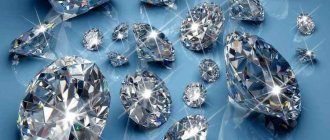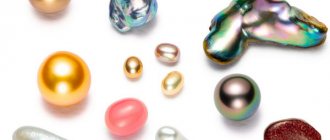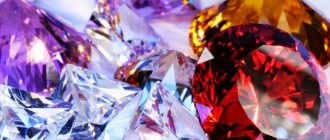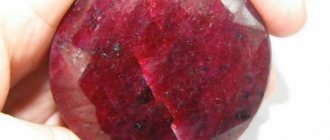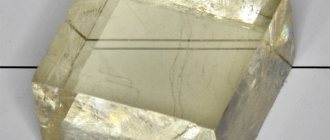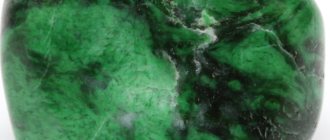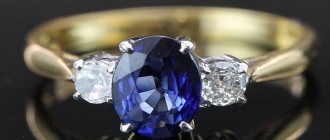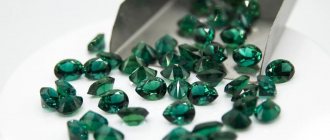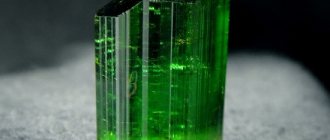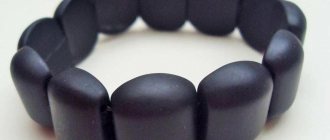Fans of precious stones know that since ancient times in Rus', sapphires were called yakhonts, and they captivated people with their magnificence for many centuries. If we talk about where sapphires are mined, their deposits have long been developed in the world, from India and Afghanistan to Russia. They have been mined in different parts of the Earth for more than six thousand years, and the rarest specimens have become an integral part of museum collections.
Sapphire: what is it?
Mineral specialists classify it as corundum. Corundum is a gemstone that can be any color except red. This means that rubies, although they belong to precious minerals, do not belong to corundum. Most people associate this stone with the color blue, and it is produced by a chemical called aluminum trioxide. Sapphire is very hard and has a pronounced shine even without special treatment, and melts at a temperature of 2000°C and above.
The colors of sapphires can be different - as always, they depend on one or another impurity in its composition. If we are talking about the most famous sapphire, which has a classic blue color, it contains iron and titanium. There are also stones in pink, green and yellow colors. There are also colorless, transparent specimens called leucosapphires. However, despite the color variety, cornflower blue stones of moderately saturated shades are most valued by jewelers.
This stone belongs to the minerals that are formed in the environment of magma - volcanic lava. Its inclusions can be found in basalt and lamprophyre layers and alkaline pegmatite rocks. The resistance of corundum to winds and destruction allows them to be mined in the form of rich deposits or placers.
Artificial stones
Natural gems are very expensive. The extraction of artificial sapphires through “cultivation” (cooking) has made the stone accessible to most people. Impurities are added to aluminum oxide, which turn into crystals when exposed to extreme heat and chemical reactions.
The process of creating unnatural material can take several weeks. It all depends on the rate of crystallization. The created mineral is cut into pieces and then processed using the cabochon technique.
Artificial sapphires are often counterfeited with synthetic stones. Duplexes have appeared on the market, in which one part is natural and the other is synthetic. Since the jewelry market is saturated with fakes, when choosing a stone you should pay attention to the following points:
- with the right lighting, transitions are visible inside a real stone, while a fake one has an ideal consistency;
- if you hold a natural gem in your hands, you can feel the coolness, but the synthetic mineral heats up quickly;
- corundum does not change color in the sun, fake stone takes on a greenish color;
- the presence of bubble inclusions is inherent only in synthetics;
- natural stone is harder than artificial stone;
- measuring the refractive index with a refractometer quickly reveals a fake (the norm is 1.762–1.778);
- a special magnifying glass determines authenticity by identifying the glued composition, grooves and other defects.
You need to be extremely careful when purchasing artificial stone, as jewelers working with synthetics have improved productive technologies. Now laboratory specimens may not glow green under ultraviolet light.
IMPORTANT! In the accompanying documents, a stone created artificially will always have one of the marks - “C” or “GT”, which indicates the production method (synthetic or hydrothermal). If there is no mark, and the seller passes off the stone as natural even though there are signs of counterfeit, he is breaking the law.
Sapphires from Kashmir
The largest deposits of cornflower blue sapphires are located in Kashmir, a famous Indian state. As already mentioned, it is the cornflower blue variety that is the most valuable stone. The place where they are found is not only in Kashmir, but also in Jamma and is famous for the fact that development began at the end of the 19th century. The altitude at which sapphires are mined in the mountains is 4000 meters. The stone is mined manually, without the use of technical means. Its depth is about ten meters.
Cashmere minerals with purple or violet hues typically make up about 15% of all natural sapphire. These are specimens that are considered high grade by jewelers. The transparency of a particular stone significantly reduces its value - it is by this criterion that Kashmiri gems, which are rightly considered the best in the world, are sorted. The famous cornflower blue corundums have the deepest and richest blue colors with purple hues. The color of the stones varies from cornflower blue to dark and light blue. Pure blue varieties are significantly inferior in cost to purple ones.
At the present stage, the number of stones found in Kashmir is not as generous as before. Therefore, it is extremely rare to find a real cornflower blue sapphire there. Corundums of “Kashmiri” colors are increasingly in demand on the jewelry market - with the difference that they were found in completely different places and cannot compete in beauty with real Indian specimens.
Price
The cost of these jewelry can be very affordable for consumers if the mineral does not belong to the first class, for example:
- the ring can cost about 3,000 rubles;
- earrings cost about 10,000 rubles;
- pendants cost about 3,000 rubles.
A mysterious sapphire instantly attracts the eye and attention; you immediately want to get it for use. There is not a single person who will remain indifferent to an amazing decoration. You should wear it only with pure thoughts in order to fully experience its positive influence.
Sapphires from Sri Lanka
Sapphire mining in Sri Lanka has been going on for more than two thousand years. Multi-colored stones are still found there, and the best of them are yellow, blue and pink, reminiscent of the Indian lotus in hue. The main development site is near the city of Ratnapura, all the way to the southern coast. Corundum is also mined manually, in the simplest way: the rock is collected in special containers and then washed.
In Ceylon, nature formed the stones in crystalline types of schists and dolomites, but as a result of the constant movement of rocks, corundums ended up in clastic rocks that settled in river beds. Sapphires occur in layers and are found at a depth that can be 35 meters or more, but they are most often found in the surface layers of the soil.
The quality of Ceylon corundum is very high. The most valuable among them are blue and sky stones of the so-called “Ceylon” color.
Properties
Sapphire is a stone to which, from time immemorial, magical properties have been attributed, largely related to its color scheme. Thus, minerals whose main shade is blue were associated by different civilizations with divine power and authority.
This precious gem has always served as a worthy decoration for the vestments of priests in India and Judea. In the Roman Empire, only priests of the supreme deity of the pantheon, Jupiter, could wear jewelry with them. In these religions, sapphire, the properties of which were especially valued by the high priests of the Roman pantheons, personified calmness and a penchant for contemplation. In the countries of the Ancient East, this stone was always spoken of as a bearer of wisdom, and in Europe - modesty and virtue.
Astrologers believe that sapphire is associated with Jupiter and Saturn, and recommend it for signs of the air and fire elements. For Leo and Sagittarius, wearing these stones will bring stability and help curb irrepressible energy and negative character traits. For unstable Aquarius and Libra, sapphires give peace, self-knowledge and confidence. Sapphire is useful for Pisces.
They used to believe in the magical properties of sapphire for women. It was believed that a lady who wanted to attract the attention of her lover needed to give him a drink from dishes inlaid with corundum. And the properties of the stone associated with the manifestation of asterism were considered the embodiment of Faith, Hope and Love.
Sapphires from Thailand
Thai sapphire has ancient deposits, and corundum from these places is characterized by a greenish tint. Read more about green sapphire →
Now Thailand is the leader in the global mining market not only for sapphires, but also for other precious stones. Corundum, called the “Jewel of the Jungle,” was discovered in Thai places not at depth, but precisely on the surface of the earth, which made the nearly 1,000-carat stone so famous.
The main place of extraction of Siamese stones is located near the settlement of Mogok, and the length of the layers in which sapphires occur is about ten kilometers. Also near the small town of Bernardmio there is another small deposit: there prospectors discovered corundum of extraordinary beauty in indigo color.
Characteristics
Now all corundums are called sapphires, with the exception of those that are red in color (rubies). From a chemical point of view, the description of the stone is as follows: sapphire is a mineral consisting almost entirely of aluminum oxide. It has a glassy luster and one of the highest strength values on the Mohs scale (the table indicates a number of 9 points). Only diamond is considered a harder mineral. The clarity and purity of sapphire can vary. There are both transparent stones, varying in purity, and completely opaque gems.
Some corundums are characterized by the phenomenon of asterism - the appearance on the surface of a stone of a star with six or twelve rays. This feature occurs in minerals with rutile inclusions, using a cutting method called “cabochon”. Star sapphires are more expensive than others.
Sapphires from Australia
A lot of gems that are successfully sold on the modern market are found in Australian territories, namely Queensland and New South Wales. Queensland's richest deposit, Anakie, covers an area of approximately 50 square kilometres. Here you can find different minerals: yellow, purple, greenish, as well as multi-colored specimens.
In the north of South Wales, a large number of sapphires were discovered, namely in the beds of flowing rivers that originate on the Inverell-Glen Inn plateau. However, for the most part these crystals are of rather low quality, and only 20% of them can be used to make high-quality jewelry. The remaining 80% of stones are characterized by a dull brown color, incomprehensible color and small size.
Application
Many will be surprised to learn what is made from sapphire other than jewelry known to the world. Corundum is used in the medical industry: for example, in the creation of artificial eye lenses. It is also used in the fields of rocketry and aviation. It is known that mineral-based glass has a high degree of strength and protection. It is these glasses that are inserted into the windows of airplanes and rockets.
In medicine, it is used not only as a material for artificial eye lenses. It is actively used in the manufacture of joint implants, which is indispensable in the field of traumatology and prosthetics. The strength and durability of such implants has long been proven throughout the world. Of course, they are very expensive, but over time they fully justify themselves.
In the industrial sector, corundum is necessary for waterjet machines. It has long been used as a material for machine nozzles, which must be especially durable. Recently, sapphire has been widely used in instrument making: for example, the substrate of a high-quality microcircuit is often made from it.
Sapphires from USA
In the American state of Montana there is a Yogo deposit, where high-quality corundums are mined, which have a unique ability to retain their shades when using artificial lighting. Their sizes are small, but the colors are beautiful: there are both cornflower blue and purple specimens. The Missouri River bed also generously provides miners with blue, yellow, green and blue gems.
Price
The cost of a stone is determined by four indicators, which in English-speaking countries are called the four C rule (Colour, Clarity, Cut, Carat weight):
- sapphire color;
- purity of the stone;
- cutting;
- carat weight.
- These characteristics of sapphire together determine its value. The most important of them is color as a decisive indicator of the quality and possibility of using a stone in jewelry.
Now these stones, so beloved by royalty, occupy a worthy place in the catalogs of the largest jewelry houses. Regardless of whether the jewelry uses a classic or innovative combination of metals and stones, sapphires will emphasize the refined taste and style of their owner.
PURCHASE AND FURTHER CARE
It is recommended to purchase sapphire gemstones only from official suppliers with certificates.
Each gem must have a tag with its own parameters.
Before purchasing, it is advisable to familiarize yourself with the rules for labeling gems in order to understand what is written on the label.
What do the inscriptions on the tags mean?
Colored gemstones are graded using the GIA scale.
We recommend: Engagement PINK SAPPHIRES
The GIA scale involves 3 parameters:
| color chart contains 33 basic shades |
| describes the variation of color from light to dark on a scale of 1 to 10, where 0 is colorless and 10 is black, each with its own coding |
| purity and strength of shade from 1 to 6, where 1 is grayish and brownish shades, and 6 is a bright, unclouded color |
Each parameter value has a coding, which is indicated on the tags for precious stones and is designed to tell the buyer everything about sapphires.
Masters are visually identified using special tables:
- color,
- tone,
- saturation.
There are nuances in evaluating stones.
If color is always a constant characteristic, then the parameters of tone and saturation can change depending on the size of the crystal: the larger it is, the darker and more saturated the color will be. The saturation can also be affected by the quality of polishing.
In Russia, where stones of blue shades are popular, a classification of two parameters of color and purity is usually used for commercial purposes:
| Category | Color | Purity |
| 1 | bright blue; |
|
| 2 | medium blue; |
|
| 3 | light blue; |
|
| 4 | — |
|
The best quality is a stone marked 1/1 or 2/2.
Sapphire marked 3/3 is cloudy and heterogeneous.
The tags indicate the origin of the stone: natural or artificial. It is important to remember: synthetic sapphire is not precious.
Of course, a specialist will advise how to choose a sapphire based on the basic characteristics of the gem.
What is important is the buyer’s inclination towards certain shades, as well as the purpose for which the jewelry is purchased.
| LIGHT SHADES | If the stone is purchased for southern countries with a lot of sunny days or for social events in well-lit rooms, you can choose darker crystals. In low light conditions, minerals will appear almost black |
| DARK SHADES | Residents of northern countries are better off giving preference to lighter crystals |
To avoid counterfeiting:
- You should first select the desired type of stone,
- study the characteristics and various variations of shades and gradients,
- know in general terms the differences from genuine stones.
Sapphire care and storage
The hardness of sapphire precludes any special care for the stone.
- The crystal only needs to be kept clean to preserve all the features of the play of light.
- The exception is artificial sapphires: they do not always withstand large amounts of sunlight and can fade.
Jewelry is NOT recommended to be worn on a regular basis.
How to distinguish an original from a fake
You can distinguish an original sapphire from an imitation or synthetic one by the following characteristics:
- A synthetically grown specimen will be ideal in all respects - in color, equally elongated bubbles in the structure. If you look at it through a magnifying glass, you can see growth stripes, which in synthetics look like eyelashes, but in natural samples they are even.
- Natural stone is always cold and takes a long time to heat up; synthetic analogues and especially colored glass heat up much faster.
- The natural mineral is second only to diamonds in hardness; it can easily scratch other gems, and especially glass.
- Synthetics will begin to glow green when exposed to ultraviolet light, while natural stone will retain its blue color.
The easiest way to check the authenticity of a blue sapphire is to ask the seller for a certificate for the product, which indicates, among other things, the origin of the insert.
